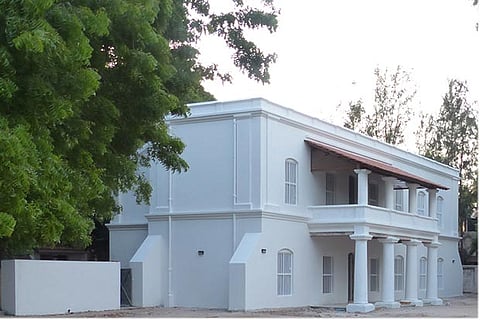

Chennai
The Ziegenbalg Museum complex in Tharangambadi, a heritage bungalow once occupied by German-born Danish missionary Bartholomäus Ziegenbalg, had been in a state of neglect for decades as the many attempts to restore it were abandoned midway. Now, under the leadership of Curator Jasmin Eppert, the 300-year-old museum has been finally restored and the doors have been thrown open for the public.
Ziegenbalg (1682-1719), believed to be the first German Protestant missionary to come to India, was sent to Tharangambadi by King Frederick IV of Denmark and Norway. He introduced a gender-equal, structured, education system for Tamilians and Europeans alike. He also founded many children’s homes and schools in the south. But his biggest achievement remains the role he played in introducing and spreading printing in India.
“Bartholomäus Ziegenbalg landed in the Malabar coast during the 18th century and spent 13 years working in South India. During this time, he started the first Tamil printing press, translated the Bible into Tamil, made grammar books for Tamil and was involved in chronicling Tamil literature,” says Daniel Manoharan, Commerce and Press Officer for Consulate General of the Federal Republic of Germany, Chennai.
Ziegenbalg’s translation of the New Testament into Tamil in 1715, and the New Jerusalem church that he and his associates constructed in 1718, are still in use today. He studied Tamil and became the first German Dravidologist. For many years, he collected material for a Tamil dictionary and wrote a Tamil grammar in Latin Grammatica Damulica, published in Halle in 1716. '
Restoration of his house was started by the German and Danish foreign offices, as part of the commemoration of the 300-year anniversary of Ziegenbalg’s arrival. But, the effort had withered away post 2006, after a few minor restoration works were done. “No major changes were made until now because a proper restoration required qualified restoration experts and historians to oversee the project. We have been able to facilitate this only now. The restoration project was taken up by the German Foreign Office under the Cultural Preservation Programme, along with the support of Francke Foundation and some Christian NGOs,” adds Daniel.
“After obtaining permission from the Tamil Nadu government, the bungalow was restored without disturbing the original structure. Francke Foundation had been preserving many of the artefacts belonging to Ziegenbalg for over 300 years. So, these have been brought back to India as part of the initiative. Articles used by Ziegenbalg, including remains of the printing machines used by him, models of the typeface letters, books have all been collected and put up in the museum,” says Jasmin Eppert, project leader for the restoration.
The museum will also offer insights into the history of the Danish-Hallian mission and the art of printing, which was first introduced by the Hallesche missionaries in India. Some of the most valuable exhibits are an original printing press from 1834, historical illustrations from the 18th and 19th century from the Archive of the Francke Foundations and the Leipzig Missionary Work. Christopher Gilbert’s documentary, Why India celebrates Bartholomäus Ziegenbalg, has also been acquired by the museum as a permanent viewing item for visitors.
Visit news.dtnext.in to explore our interactive epaper!
Download the DT Next app for more exciting features!
Click here for iOS
Click here for Android